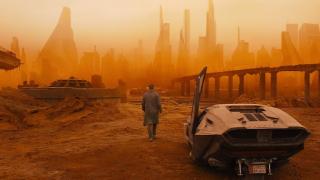Film Review- Blade Runner 2049
2hrs 34 minutes, R for graphic violence and nudity
Fair Value of Blade Runner 2049: $24. Easily worth multiple viewings, with elaborate scenes and gorgeous visuals making an IMAX premium justifiable. A worthy successor to the classic that invented Cyberpunk.

Future Parables Must Be Coded in Chrome and Holograms: To broach an uncomfortable truth, fiction first applies a fantastic lacquer. Blade Runner 2049 is a a world alight in titanic holograms, policed by flying cars, where the fugitive slaves are hunted by genetic supermen. It’s our world, stretched further; past the point of no return of the ecosystem, where the gap between the elite and the working class is more akin to the distance between mortal and god than between peasant and king. It manages to be all of J.G. Ballard’s bad futures at once: Nevada, is the burning world, the Central Valley of California is buried under tarps of plastic.
And Los Angeles resembles Beijing. I’ve lived in Baotou, and spent a few weeks in Beijing. Baotou is a relentless city of industrial ambition, subject to freezing winters and dust storms. The smog in Beijing is so thick that it has tangibility, you can feel the weight of the air inside of your lungs. The world of Blade Runner is all of the worst aspects of our present world, overwritten onto the landscape of America: the Pacific plastic islands washed up on to Venice beach, the child sweatshops of Manila instead in West Covina. And yet, there is a grandeur.

Ruin Value: A concept of fascism was the idea of ruin value, which was building architecture not only to serve the utility of the time in which it was inhabited and functional, but also to build with an eye towards the long-term impact and effect of the building. Beijing, for all of the crowding and pollution, is an architects paradise, an endless sprawl of every school and period of architectural design. Blade Runner 2049, like Beijing, is architecture porn. It is a spectacular travelogue of a world that is almost post-human. And in this way, it is an expansion the world of the original Blade Runner.
Cyberpunk is Noir with a Bad Case of Technophilia– I once failed to explain the importance of Blade Runner to a friend of mine who disliked the film. To him, I explained how the film follows the basic structure and pacing of a noir film. He though the film was too sedate, too inactive. A pity. Some people can’t appreciate scotch, either, and other people lack the patience to listen to Coltrane. The original Blade Runner is a film that you have to soak in; the principal charm lies in the elaborate and exquisite composition of the world that is given out to you shot by shot.
The new film also works within the trappings of modern noir, but it incorporates the innovations that have been made in the genre. You will see the influences of Memento, of Shutter Island, and of Se7en into the detective story. And yet, at the same time, a great many of the classic beats and set-pieces of the noir progression remain. You have the initial assignment; the meeting with the wealthy bigwig with the interest; the introduction of a love interest; the gradual, unwinding accrual of the factions that shall eventually collide.

Explicit Full Frontal Technophilia: And at the same time, Blade Runner 2049 also builds on the excellent foundations of the original by incorporating some of the most mesmerizing themes of recent science fiction cinema/television. The romantic story-line of Blade Runner 2049 is a tale of love between a boy (Ryan Gosling) and his digital assistant (Ana de Armas), a tale that you will recognize from Spike Jonze’s Her. But Blade Runner 2049 also steals from some of the recent greats: there’s the whole theme of memory editing and distortion (Black Mirror, The Congress), and the idea of a post-apocalyptic world that has survived the E-Collapse (Mr. Robot). Blade Runner 2049 uses these sub-stories to make it into more than a film that is simply about Replicants vs. Original Humans.
I Believe that Corporations are the Future (and that’s not good). Take a moment to appreciate the unique beauty of your period in the evolutionary progression of hominids. Of course, its less than 50% likely that our species will outlive the 21st century, less than 90% likely this millennium. But you are a missing link in evolution, just as the Cro-Magnon and the Habilis before you. We are a highly eusocial predator that has achieved domination of the food chain by evolving from the hunting pack to the tribe. And from the tribe to the polis, and the polis to the confederacy, and the confederacy to the nation state. And now the supra-organism is coming.
In a terrible, trans-human way, corporations are people. Or, perhaps, it is better to say, they are meta-organisms; social fictions that accrue, direct, and specialize individual humans in the pursuit of their own predatory expansion and reproduction. The corporation is the next rung on our transformation from pack predators to a hyper-eusocial hive organism.
The mega-corporation is like an ant-hill, or a bee hive. You have, at the apex, the CEO, directing the rules governing reproduction. Instead of a dominion of breeder matriarchs, we shall have governance by what I call the Predator Kings. Donald Trump is an extremely poor facsimile of a Predator King; Al Dunlop is a better concrete example; and Patrick Bateman, of American Psycho, is the idealized version. The Predator King is a highly intelligent domineering sociopath who is devoted to exploiting social hierarchies to maximize their influence and personal placement, while able to sublimate maladaptive expressions of their psychopathy. Beyond that, Blade Runner shows us the other castes of the hive: the police/enforcers, the overseers, and the laboring proles.
My point is that our present time, of the Enlightenment, of egalitarianism and human rights, may in fact be an ephemeral interlude, as notable and also as transitory as Democratic Athens or Golden Florence. When I suggest that corporatocracy and neo-feudalism is becoming the future, I do not mean to suggest that such a destination is desirable, any more than a tribe of hunter-gatherers would find the slavery of an agricultural society to be an adaption.
Niander Wallace (Jared Leto), the arch-villain of Blade Runner 2049 is one such Predator King. He has adapted the appearance of an Old Testament prophet, or of a young lumbersexual version of Jehovah. And he is obsessed with controlling the means of reproduction. For the means of reproduction are the ultimate means of production. He (its almost always a he, at least in agrarian and post-agrarian periods) who dictates the conditions and social systems of human reproduction ultimately sets the competitive values that define social worth in all genders.
To explain my theories about Blade Runner, I’m going to have to establish a bit of history and a bit of philosophy.

Lets Talk About Simulacra: Jean Baudrillard developed the concept of a simulacra. A simulacra is a copy of a thing to which no original object exists. The truth of the simulacra is that there is no truth- no original reality. Some examples of simulacra in historical research include the morning star and the chastity belt. There’s no evidence of either item being used in the real middle ages, but they illustrate the accrued myths of the mores of the middle ages, and so copies developed in the renaissance, which then became the basis for more copies.
We are, all of us, simulacra. We are copies of copies of alleles and chromosomes, a vast genetic palimpsest who are imbued by the random cascades of causality that generate our memory into an illusion of individuality and discreteness. And yet, I have strode and gazed upon the wind blowing dust into the San Benito creek, as my father did; and as his father did; and his father also. We exist in a perpetually re-iterating self-referential mythological construct of the world. We inherit this myth of the world order from our teachers, our memories and our culture.
And Who Tills the Fields? Why the Slaves of Course: I believe that the history of the world, and the history of the American civilization in particular, derives from successive schemas for organizing and compelling exploited labor. The earliest period was the Conquista, where capitalism managed enslaved indigenous peoples; this was succeeded by indentured servitude, which was followed by slavery, which was followed by Jim Crow/ peonage, then was followed by what I refer to as the Bracero period of exploitation of Latinx immigrants (roughly 1936-2004), succeeded by our current Prison-Industrial complex (which spans roughly 1972-present I consider the beginning of the War on Drugs to be the start of the Prison-Industrial era).
Each of these eras involves a new artificially constructed ideology to justify the exploitation. At first, the basis was that the slaves were heathens. Then, debt payment was the basis. Then race became the basis of exploitation. The two periods of total systematic black oppression involved two different ideologies. At first, slavery was justified in a patriarchal notion, that blacks were being civilized by the plantations of the Antebellum south. As Jim Crow arose, a new system of scientific racism and eugenics was developed in order to justify the disenfranchisement. The schema of exploitation of the Latin peoples was primarily derived from linguistics- hence the ongoing focus during the Pete Wilson era on the primacy of the English language. And now, we are supposedly an enlightened civilization. Now, we only enslave people who have broken the law. People who have been so wicked as to smoke marijuana, or to drive with a broken tail-light, or to not have paid a fine or a payment in sufficient time. Such scoundrels deserve to be slaves, obviously.
The message of Phillip K. Dicks dystopia is that mans drive to partition and oppress mankind will only find new schemes in the future. Again, the circumstances of your birth determine whether you have slave or non-slave status; but in distant 2049, its not the color of your skin, but the manner of your womb that determines your fate.

Whats the Big Idea? There are no replicants in Blade Runner. In the end, it doesn’t actually matter if Decker or Agent K is born of a womb or born from a vat. There are genetically engineered humans, for certain, but the boundary between human and skin-job is more of an artificial distinction than a relevant issue. Also, it is important to remember that it is a post-apocalyptic setting; there was a Blackout thirty years prior to the story of Blade Runner 2049, in which all electronic records were destroyed. The entire society of Blade Runner exists in a world where memories can be edited and implanted; given that, and given the event of the Blackout, the separation of replicant and organic human is a contrivance, no more and no less meaningful than the distinction between Hutu and Tutsi, or between Serb and Bosniak.
Both cloning and digital re-creation allow the film to depict a universe that is haunted by solid ghosts. Elvis dances on an endless stuttering loop within an abandoned casino; jukeboxes conjure Frank Sinatra. And the characters of the old film are reprised, genetically re-constituted, as they were in their 2019 and our 1982. A part of the definition of the simulacra is that a simulacra doesn’t know that it is inauthentic. And the lie that capitalism conditions into us is that we are somehow exceptional, distinct and unique and discrete, and not merely re-iterations and reprisals of our ancestry, and the inherited resources of our family units.
And that is the value of both Blade Runner films. The Blade Runner is the protagonist, and so we are conditioned to adopt their point of view. But Blade Runners are assassins, fugitive slave hunters. The real core message and value of Blade Runner lies in empathy- in understanding that you could just as easily be conditioned into injustice as the characters of the film. We must be exceedingly careful that we do not allow technological innovation to be the Trojan horse for a new slavery, for the masters of capital are ever eager to adopt a new strategy of oppression. Blade Runner 2049 is the rare worthy sequel that not only upholds but further expands upon the genius of the original film.